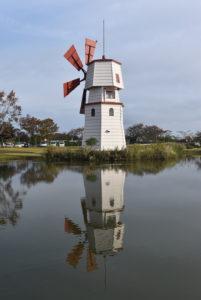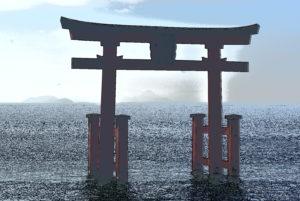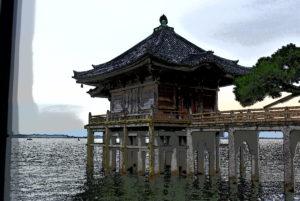
Fatigue, muscle soreness and endurance were going to be the order of the day on the Kangaeroo crew’s second leg of Biwaichi, the circumnavigation of Biwa, Japan’s largest lake.
Mrs. Kangaeroo had completed the 70-plus kilometer first leg with barely a hint of trouble, but not being used to cycling, it was going to be the second day that presented a big test as it would display her recuperative powers.
Typically, she was magnificent! She woke with a huge smile and full of beans, getting into her Kangaeroo.com jersey and racing down to the hotel restaurant for the fancy buffet breakfast.

The buffet, as is often the case, left a bit to be desired (unless you’re really into Japanese breakfasts, in which case it was quite acceptable).
The restaurant, however, gave early risers like the Kangaeroo crew a great boost by having massive windows with a lake view, from which we were greeted with a glorious sunrise.

Following the previous day’s magnificent weather, the rising sun also lifted expectations, so we set off with a light heart and deep gratitude, especially as the hotel presented us with a bottle of water each to drink on our journey.
Once again, the early part of the ride offered a wonderfully maintained bike track that made riding a delight.

After about 3/4 hour on the road we cam across a huge windmill.
Closer inspection revealed that the windmill was just one of three in the area, and these served as symbols for what looked to be a wonderful glamping site.
Seeing the windmills was to be the highlight of the early morning.
Continuing along the bike track there was little to see as one campsite followed another on the lake side to our left.

To our right were large numbers of holiday houses, most of them apparently deserted.
The “Japocalypse” of a stagnant economy, low birthrate and rapid aging was clearly evident near Lake Biwa, which is actually more of a vibrant place than most due its proximity to the Keihanshin megacity made up of Osaka, Kyoto and Kobe. Yet the decay and degradation afflicting much of non-urban Japan was clearly evident, together with the hangover of the 1980s bubble economy.

Most notable views came not from the lake, but the mountains of Takashima, which were covered by a blanket of mist and clouds.
It was quite an impressive view, especially as the day was essentially sunny, which made the clouds stand out more.

Also spectacular was a torii Shinto shrine gate in the water, which is one of the symbols of Lake Biwa.
Unfortunately, it’s located on a part of the Biwaichi course that uses main roads.
Stopping was not only inconvenient, but also uncomfortable.

The Kangaeroo crew made a brief stop, took a shot and headed on, hoping that we would be back on isolated bike tracks and getting lake views while off the main road as soon as possible.
It was not to be.
In fact, the course essentially continued along the main road through to the bottom of the lake, becoming more built up with each kilometer traversed as we drew ever closer to Kyoto.

What’s worse, though, was that there were not a great deal of lake views.
Considering we were on a circumnavigation of the lake, not being able to see the body of water was a bit disappointing and detracted from the sheer delight of the previous day’s riding.
The lake side has its appeals, with resort hotels, pachinko parlors, shopping malls, speedboat races and other pleasures that attract the local population, but it’s not really fare that the Kangaeroo crew get into.
One highlight, however, was passing through Ogoto, a place Kangaeroo had long sought to see in person but had never gotten around to doing so.

Ogoto is the location of one of Japan’s top soapland brothel districts, joining Kawasaki and Gifu.
It was this dubious honor that may have owed to the unattractive nature of the road.
There is a story, possibly apocryphal, of the late Emperor Hirohito touring Lake Biwa in the 1970s.
It was then the heyday of the soapland, or Turkish baths (toruko buro) as they were then known.

Route planners realized the Emperor, who had been born a god even though he had long renounced that status by then, would be driving through the fleshpits of Ogoto.
Quickly, a solution was sought, and within mere weeks a new road was built that avoided the district and saved the Emperor from having to see it.
Forward 40–odd years and it appears economics and changing mores have done to the Ogoto red light district what the prudes pulled off in the Me era, with little sign of the area being anywhere near its once heralded glory.

Drawing to a close of the day’s ride, the Kangaeroo crew came across a quaint, typically German-style cottage.
It looked so out of place it was worth a look. Turns out it was a restaurant set up as part of a sister city relationship.
Rumbling tummies decided it would be Deutschland uber alles, so we waited for the better part of an hour for a place.

It was worth it. The veal and pork served were exquisite and the garden setting delightful, even as the day began to cloud over.
While waiting to dine, Kangaeroo also realized he’d had his camera switched to the Effects mode for most of the day, making nearly all of the 200 or so photos he’d taken look like cartoons or something out of a Ralph Bakshi movie instead of photographs. A Google search revealed that the process was irreversible, which put a bit of a dampener on the day.
Worse was to come after the Kangaeroo crew rounded the bottom of the lake at Seta and reached their hotel, the Royal Oak Shiga.

Expectations were high as it was a beautiful hotel commanding a hefty rate, but worth indulging in, according to Mrs. Kangaeroo.
How hefty, though, we weren’t to know until checking in.
It was then we discovered that the hotel had double-booked us and double-charged us, inclujding one charge for a pricey suite.
Upon investigation, the hotel admitted its fault, contacted the booking service and pleaded for the charge to be refunded.
The booking service, Agoda.com., was less than forthcoming.
For he next few hours, the Kangaeroo crew went back and forth with the hotel Agoda, trying to fix the fuck-up.

Eventually, after we rejected the offer of a refund in Agoda dollars valid for a few weeks, the booking service backed down and agreed to a full refund.
By that time, the day had been spoiled and we had paid for a pricey hotel room that we could barely enjoy.
At least we learned never to use Agoda or the Royal Oak chain again.










